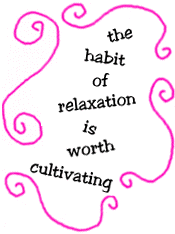 As the warm summer sun beats down on the streets of Washington, D.C., I’ve been wondering more and more about why people jog all the time, when they could instead be relaxing in a hammock under a tree with a nice cool glass of lemonade in hand. And recently my work friends and I have been pondering deliciously the idea of taking an afternoon siesta. Wouldn’t life be much easier? Here are some thoughts on the fine art of resting, brought to you by Harold S. Diehl’s book titled Elements of Healthful Living.
As the warm summer sun beats down on the streets of Washington, D.C., I’ve been wondering more and more about why people jog all the time, when they could instead be relaxing in a hammock under a tree with a nice cool glass of lemonade in hand. And recently my work friends and I have been pondering deliciously the idea of taking an afternoon siesta. Wouldn’t life be much easier? Here are some thoughts on the fine art of resting, brought to you by Harold S. Diehl’s book titled Elements of Healthful Living.
For more on the same subject, you might also want to read Wisdom and Beauty in Rest (from 1902). Can you tell I just love this topic?
1942: Rest
![]() Facilities for exercise abound on every hand. Every community has a gymnasium and its playground. Great national organizations, educational institutions, and even governments support athletic programs. But who ever heard of providing a place for rest and relaxation? The very suggestion seems fantastic. Yet how many weary, footsore people are crowded into the business districts of our cities every day? People for whom a few moments of relaxation would give life a different hue. People who need rest, not exercise.
Facilities for exercise abound on every hand. Every community has a gymnasium and its playground. Great national organizations, educational institutions, and even governments support athletic programs. But who ever heard of providing a place for rest and relaxation? The very suggestion seems fantastic. Yet how many weary, footsore people are crowded into the business districts of our cities every day? People for whom a few moments of relaxation would give life a different hue. People who need rest, not exercise.
Industries, studying the work records of employees throughout the day, find that efficiency declines toward the latter part of the morning, improves after lunch, and then declines again more rapidly in the afternoon. They find also that accidents are most frequent during the periods of accumulating fatigue; and that 15-minute rest periods in mid-morning and mid-afternoon result in increased efficiency which more than compensates for the time ‘wasted.’
Many individuals have made similar discoveries concerning their own well-being. The most famous surgeon in the world long made it an inviolate rule to have a 15- or 20-minute rest each day after lunch. No matter where he was or how pressed for time, he slipped away for a brief doze and returned refreshed. This practice of relaxation undoubtedly was an important factor in the maintenance of his health and vitality through many years of a strenuous and useful life.
The habit of relaxation is worth cultivating. A few minutes on a davenport or comfortable chair with the eyes closed, the mind at rest, and every muscle relaxed will do much to conserve physical and nervous energy. At first complete relaxation probably can be attained only for a few minutes at a time but this should be increased to at least 10 or 15 minutes once or twice a day.
The time may come when we shall have rest clubs as well as athletic clubs, but not yet. We are still too much inclined to boast of the small amount of rest on which we can get along. We still cling to the mad desire to get everything done in a day. To entice the average American to rest in the daytime one must camouflage the rest with mysterious measures such as light treatments, massage, or sun bathing. Possibly when as a nation we have grown up, we shall learn, as many of the old-world countries have learned, to take life more leisurely, to get a little more out of life as we go along, with a friendly chat and a cup of tea to break the tension of the day.![]()
Source: Diehl, Harold S. Elements of Healthful Living. New York: McGraw-Hill Book Company, 1942.
~ pp. 109-110 ~